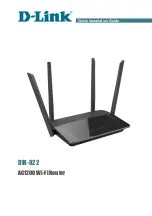
There are up to 7 security modes depending on AP model variations:
y
Open System:
No authentication, no data encryption.
y
Static WEP:
WEP (Wired Equivalent Privacy) keys must be manually
configured.
y
Static TKIP (WPA-PSK):
Only TKIP (Temporal Key Integrity Protocol)
mechanism of WPA (Wi-Fi Protected Access) is enabled. In this mode,
users have to specify the Pre-shared key, which will be used by the
TKIP engine as a master key to generate keys that actually encrypt
outgoing
y
IEEE 802.1x EAP without Encryption (EAP-MD5):
The IEEE 802.1x
functionality is enabled and the user-name/password-based EAP-
MD5 authentication is used. No data encryption.
y
IEEE 802.1x EAP with Static WEP (EAP-MD5):
The IEEE 802.1x
functionality is enabled and the user-name/password-based EAP-
MD5 authentication is used. Data encryption is achieved by static
WEP.
y
IEEE 802.1x EAP with Dynamic WEP (EAP-TLS, EAP-TTLS,
PEAP):
The IEEE 802.1x functionality is enabled and dynamic WEP
key distribution authentication (EAP-TLS, EAP-TTLS, or PEAP) is
used. Data encryption is achieved by dynamic WEP.
y
IEEE 802.1x EAP with Dynamic TKIP (WPA):
This is a full WPA
mode, in which both the TKIP and IEEE 802.1x dynamic key
exchange mechanisms are enabled. The AP is highly secured in this
mode.
In the above security modes, a back-end RADIUS (Remote Authentication
Dial-In User Service) server is needed if IEEE 802.1x functionality is enabled.
According to the IEEE 802.11 standard, WEP can be used for authentication
and data encryption. Normally, Shared Key authentication is used if WEP
data encryption is enabled. In rare cases, Open System authentication may
be used when WEP data encryption is enabled. The Authentication algorithm
setting is provided for better compatibility with wireless clients with various
WLAN network adapters. There are three options available, including Open
System, Shared Key, and Auto.
29













































